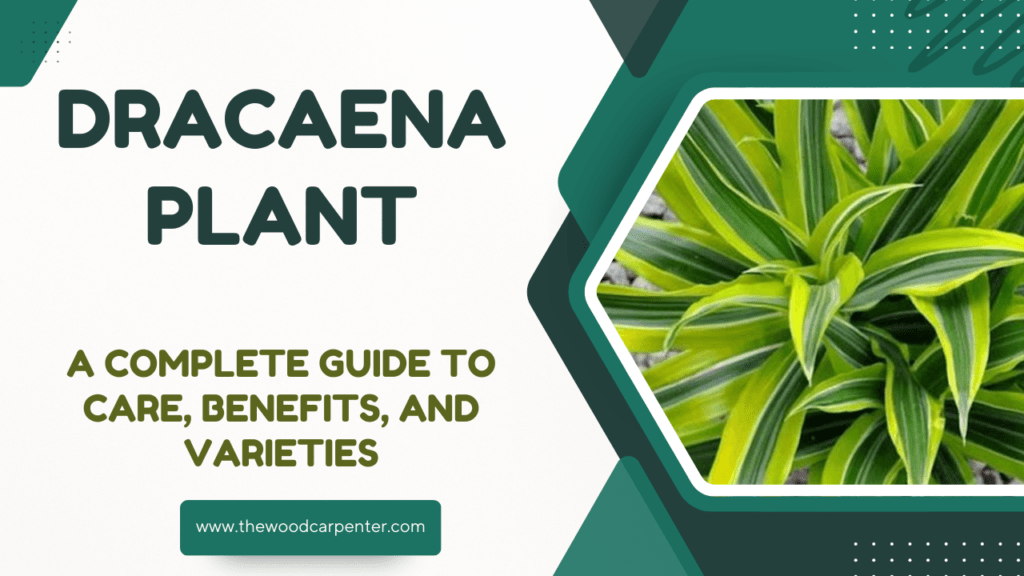
Dracaena plants are very popular houseplants around the world. People love them because they look beautiful, are easy to take care of, and can even help clean the air.
Whether you’re new to plants or already have some experience, Dracaena is a great choice for any indoor space. This guide will teach you all about how to care for Dracaena, the benefits it offers, and the best types to grow at home.
Why Choose Dracaena?
Dracaena includes over 120 different types, from small bushes to tall, tree-like plants. Their leaves often have pretty patterns or stripes in colors like green, yellow, red, or white, which makes them stand out in any room.
They are also strong, don’t need much water, and help improve air quality—perfect for people who want a plant that doesn’t need a lot of work.
Dracaena Plant Care: Step-by-Step
Light Requirements
Dracaenas thrive in bright, indirect light but can tolerate low-light conditions indoors. Direct sunlight may scorch their leaves, so filtered light or semi-shade is ideal.
Outdoors, choose a spot with dappled sun or partial shade.
Soil and Potting
- Use a well-draining, slightly acidic potting mix—peat-based commercial mixes work well.
- When planting outdoors in tropical regions, ensure the soil is rich and drains easily.
Watering
- Keep the soil consistently moist during the growing season (spring through fall), but never soggy. Allow the top inch of soil to dry out before watering again.
- Reduce watering in winter, letting the soil dry more between waterings.
- Dracaenas are sensitive to fluoride in tap water, which can cause leaf tip burn. Use distilled, rain, or filtered water when possible.
Temperature and Humidity
Optimal temperatures are 65–80°F (18–27°C). Avoid exposing the plant to temperatures below 50°F (10°C) or cold drafts.
Dracaenas prefer moderate to high humidity. If your home is dry, especially in winter, use a humidifier or place the pot on a pebble tray with water.

Fertilizing
Feed monthly with a balanced, water-soluble fertilizer during spring and summer. Stop fertilizing in fall and winter when growth slows.
Pruning and Cleaning
Prune in spring or summer to control height and shape. Remove yellowing or dead leaves as they appear.
Dracaena leaves attract dust; rinse them occasionally with a gentle shower or wipe with a damp cloth.
Propagation
Dracaenas are easy to propagate from stem cuttings. Take an 8-inch cutting, remove lower leaves, dip the cut end in rooting hormone, and plant in moist soil or water. New roots should appear in a few weeks.
Also read:
Dieffenbachia (Dumb Cane) – How to Grow and Care for it
Health Benefits of Dracaena
Air Purification
Dracaena is one of the best plants for cleaning the air, according to a NASA study. It helps remove harmful chemicals like benzene, formaldehyde, and trichloroethylene, making the air in your home cleaner and healthier.
Improves Well-being
Keeping Dracaena in your home can help you feel more relaxed and less stressed. Green plants like Dracaena can also boost your mood, help you focus better, and increase your productivity—great for both home and office.
Helps with Humidity and Allergies
Dracaena gives off water vapor, which adds moisture to the air. This can help with dry air problems and make breathing easier, especially for people with allergies.
Brings Good Luck
Some types of Dracaena, like Dracaena sanderiana (also known as Lucky Bamboo), are believed to bring good luck, money, and positive energy in Feng Shui and Vastu traditions.
Popular Dracaena Varieties
| Variety | Description | Height | Features |
| Dracaena marginata | Thin, arching leaves with red edges | 6–10 ft | Air-purifying, drought-tolerant |
| Dracaena fragrans | Broad, glossy green leaves, sometimes variegated | 3–6 ft | Fragrant flowers, easy care |
| Dracaena sanderiana | Known as Lucky Bamboo, spiral stems, green leaves | Up to 3 ft | Symbol of luck, grows in water |
| Dracaena reflexa | Wavy, lance-shaped leaves, often variegated | 3–8 ft | Decorative, adaptable |
| Dracaena draco | Dragon Tree, thick trunk, sword-like leaves | 10–20 ft+ | Striking form, slow-growing |
Troubleshooting Common Dracaena Problems
Yellowing Leaves: Usually caused by overwatering, poor drainage, or low humidity. Let soil dry between waterings and increase humidity if needed.
Brown Leaf Tips: Often due to fluoride toxicity or dry air. Use distilled water and boost humidity.
Drooping Leaves: Can result from underwatering, overwatering, or sudden temperature changes.
Stunted Growth: May indicate low light, nutrient deficiency, or being root-bound. Move to a brighter spot, fertilize, or repot as needed.
Frequently Asked Questions (FAQs)
Q: Are Dracaena plants safe for pets?
A: Dracaena is toxic to cats and dogs if ingested, causing vomiting and drooling. Keep out of reach of pets.
Q: How often should I water my Dracaena?
A: Water when the top inch of soil feels dry. In spring and summer, this may be once a week; less often in winter.
Q: Can Dracaena grow in low light?
A: Yes, Dracaena tolerates low light but grows best in bright, indirect light.
Q: Why are the leaves turning brown at the edges?
A: Brown edges are often due to fluoride in tap water or low humidity. Use distilled water and increase humidity.
Q: How do I propagate Dracaena?
A: Take a healthy stem cutting, remove lower leaves, and root in water or moist soil in bright, indirect light.
Conclusion
Dracaena plants are a great choice if you want a good-looking, easy-to-care-for houseplant that also improves your health. They clean the air, help you feel less stressed, and come in many beautiful types.
Just follow the care tips above, pick the one you like best, and enjoy all the amazing benefits Dracaena can bring to your home.

